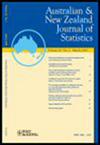Globally intensity-reweighted estimators for K- and pair correlation functions
IF 0.8
4区 数学
Q3 STATISTICS & PROBABILITY
引用次数: 9
Abstract
We introduce new estimators of the inhomogeneous K-function and the pair correlation function of a spatial point process as well as the cross K-function and the cross pair correlation function of a bivariate spatial point process under the assumption of second-order intensity-reweighted stationarity. These estimators rely on a ‘global’ normalisation factor which depends on an aggregation of the intensity function, while the existing estimators depend ‘locally’ on the intensity function at the individual observed points. The advantages of our new global estimators over the existing local estimators are demonstrated by theoretical considerations and a simulation study.
K-和对相关函数的全局强度重加权估计
在二阶强度重加权平稳性的假设下,引入了空间点过程的非齐次k函数和对相关函数的新估计,以及二元空间点过程的交叉k函数和交叉对相关函数的新估计。这些估计依赖于一个“全局”归一化因子,该因子依赖于强度函数的集合,而现有的估计依赖于单个观测点的“局部”强度函数。通过理论分析和仿真研究,证明了我们的全局估计器相对于现有的局部估计器的优越性。
本文章由计算机程序翻译,如有差异,请以英文原文为准。
求助全文
约1分钟内获得全文
求助全文
来源期刊
CiteScore
1.30
自引率
9.10%
发文量
31
审稿时长
>12 weeks
期刊介绍:
The Australian & New Zealand Journal of Statistics is an international journal managed jointly by the Statistical Society of Australia and the New Zealand Statistical Association. Its purpose is to report significant and novel contributions in statistics, ranging across articles on statistical theory, methodology, applications and computing. The journal has a particular focus on statistical techniques that can be readily applied to real-world problems, and on application papers with an Australasian emphasis. Outstanding articles submitted to the journal may be selected as Discussion Papers, to be read at a meeting of either the Statistical Society of Australia or the New Zealand Statistical Association.
The main body of the journal is divided into three sections.
The Theory and Methods Section publishes papers containing original contributions to the theory and methodology of statistics, econometrics and probability, and seeks papers motivated by a real problem and which demonstrate the proposed theory or methodology in that situation. There is a strong preference for papers motivated by, and illustrated with, real data.
The Applications Section publishes papers demonstrating applications of statistical techniques to problems faced by users of statistics in the sciences, government and industry. A particular focus is the application of newly developed statistical methodology to real data and the demonstration of better use of established statistical methodology in an area of application. It seeks to aid teachers of statistics by placing statistical methods in context.
The Statistical Computing Section publishes papers containing new algorithms, code snippets, or software descriptions (for open source software only) which enhance the field through the application of computing. Preference is given to papers featuring publically available code and/or data, and to those motivated by statistical methods for practical problems.

 求助内容:
求助内容: 应助结果提醒方式:
应助结果提醒方式:


